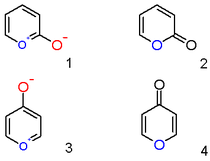Pyrylium: Difference between revisions
Fixed typo Tags: Mobile edit Mobile web edit |
Jorge Stolfi (talk | contribs) General reorg, sectioning. One ref |
||
| Line 41: | Line 41: | ||
}} |
}} |
||
'''Pyrylium''' is a [[cation]] (positive [[ion]]) consisting of a six-membered ring of five [[carbon]] atoms, each with one [[hydrogen]] atom, and one positively charged [[oxygen]] atom. The bonds in the ring are [[conjugated system|conjugated]] as in [[benzene]], giving it an [[aromaticity|aromatic]] character. In particular, because of the positive charge, the oxygen atom is [[valence (chemistry)|trivalent]]. Pyrilium is a mono-[[cyclic compound|cyclic]] and [[heterocyclic compound|heterocyclic]] compound, one of the [[oxonium ion]]s. |
'''Pyrylium''' is a [[cation]] (positive [[ion]]) with formula {{chem|C5H5O|+}}, consisting of a six-membered ring of five [[carbon]] atoms, each with one [[hydrogen]] atom, and one positively charged [[oxygen]] atom. The bonds in the ring are [[conjugated system|conjugated]] as in [[benzene]], giving it an [[aromaticity|aromatic]] character. In particular, because of the positive charge, the oxygen atom is [[valence (chemistry)|trivalent]]. Pyrilium is a mono-[[cyclic compound|cyclic]] and [[heterocyclic compound|heterocyclic]] compound, one of the [[oxonium ion]]s. |
||
==Salts== |
|||
Pyrylium and its derivatives form stable [[salt (chemistry)|salt]]s with a variety of anions.<ref>{{cite book |title= Heterocyclic Chemistry |author= Gilchrist, T. L. |isbn= 0-582-27843-0}}</ref><ref>{{cite journal |author1=Balaban, A. T. |author2=Schroth, W. |author3=Fischer, G. |title= Pyrylium Salts. I. Synthesis |journal= Advances in Heterocyclic Chemistry |editor1=Katritzky, A. R. |editor2=Boulton, A. J. |publisher= Academic Press |location= New York |year= 1969 |volume= 10 |pages= 241–326 |doi= 10.1016/S0065-2725(08)60499-7}}</ref><ref>{{cite book |author1=Balaban, A. T. |author2=Dinculescu, A. |author3=Dorofeenko, G. N. |author4=Fischer, G. W. |author5=Koblik, A. V. |author6=Mezheritskii, V. V. |author7=Schroth, W. |title= Pyrylium Salts. Syntheses, Reactions and Physical Properties |series= Advances in Heterocyclic Chemistry: Supplement |volume= 2 |editor= Katritzky, A. R. |publisher= Academic Press |location= New York |year= 1982 |isbn= 978-0-12-020652-0}}</ref><ref>{{cite book |author= Balaban, A. T. |chapter= The Pyrylium Cation as a Synthon in Organic Chemistry |title= New Trends in Heterocyclic Chemistry |editor1=Mitra, R. B. |editor2=Ayyangar, N. R. |editor3=Gogte, V. N. |editor4=Acheson, R. M. |editor5=Cromwell, N. |publisher= Elsevier |location= Amsterdam |year= 1979 |pages= 79–111 |isbn= 978-0-444-41737-4 |series= Studies in Organic Chemistry |volume= 3}}</ref><ref>{{cite book |author= Balaban, A. T. |chapter= Pyrylium Salts as Useful Synthons |title= Organic Synthesis: Modern Trends |editor= Chizov, O. |publisher= Blackwell |location= Oxford |year= 1987 |pages= 263–274 |isbn= 0-632-02014-8}}</ref><ref>{{cite book |author1=Balaban, T. S. |author2=Balaban, A. T. |chapter= Pyrylium Salts |series= Science of Synthesis; Houben-Weyl Methods of Molecular Transformations |publisher= Georg Thieme Verlag |location= Stuttgart |year= 2003 |volume= 14 |title= Hetarenes and Related Ring Systems, Six-membered Hetarenes with one Chalcogen |pages= 11–200 |isbn= 978-3-13-118641-6}}</ref> |
Pyrylium and its derivatives form stable [[salt (chemistry)|salt]]s with a variety of anions.<ref>{{cite book |title= Heterocyclic Chemistry |author= Gilchrist, T. L. |isbn= 0-582-27843-0}}</ref><ref>{{cite journal |author1=Balaban, A. T. |author2=Schroth, W. |author3=Fischer, G. |title= Pyrylium Salts. I. Synthesis |journal= Advances in Heterocyclic Chemistry |editor1=Katritzky, A. R. |editor2=Boulton, A. J. |publisher= Academic Press |location= New York |year= 1969 |volume= 10 |pages= 241–326 |doi= 10.1016/S0065-2725(08)60499-7}}</ref><ref>{{cite book |author1=Balaban, A. T. |author2=Dinculescu, A. |author3=Dorofeenko, G. N. |author4=Fischer, G. W. |author5=Koblik, A. V. |author6=Mezheritskii, V. V. |author7=Schroth, W. |title= Pyrylium Salts. Syntheses, Reactions and Physical Properties |series= Advances in Heterocyclic Chemistry: Supplement |volume= 2 |editor= Katritzky, A. R. |publisher= Academic Press |location= New York |year= 1982 |isbn= 978-0-12-020652-0}}</ref><ref>{{cite book |author= Balaban, A. T. |chapter= The Pyrylium Cation as a Synthon in Organic Chemistry |title= New Trends in Heterocyclic Chemistry |editor1=Mitra, R. B. |editor2=Ayyangar, N. R. |editor3=Gogte, V. N. |editor4=Acheson, R. M. |editor5=Cromwell, N. |publisher= Elsevier |location= Amsterdam |year= 1979 |pages= 79–111 |isbn= 978-0-444-41737-4 |series= Studies in Organic Chemistry |volume= 3}}</ref><ref>{{cite book |author= Balaban, A. T. |chapter= Pyrylium Salts as Useful Synthons |title= Organic Synthesis: Modern Trends |editor= Chizov, O. |publisher= Blackwell |location= Oxford |year= 1987 |pages= 263–274 |isbn= 0-632-02014-8}}</ref><ref>{{cite book |author1=Balaban, T. S. |author2=Balaban, A. T. |chapter= Pyrylium Salts |series= Science of Synthesis; Houben-Weyl Methods of Molecular Transformations |publisher= Georg Thieme Verlag |location= Stuttgart |year= 2003 |volume= 14 |title= Hetarenes and Related Ring Systems, Six-membered Hetarenes with one Chalcogen |pages= 11–200 |isbn= 978-3-13-118641-6}}</ref> |
||
<!---Pyrylium [[perchlorate]] is soluble in [[acetonitrile]]. |
|||
Trimethylpyrylium perchlorate has a melting point of 246-247 °C. |
|||
2,4,6-Triphenylpyrylium tetrafluoroborate, yellow needles, mp 214-215° |
|||
2-Methyl-4,6-diphenyl pyrylium chloride: light yellow, mp 125-126.--> |
|||
==Derivatives== |
|||
Many important cations are formally derived from pyrylium by substitution of various [[functional group]]s for some or all the hydrogens in the ring. The [[2,4,6-triphenylpyrilium]] is an important example.<ref name=bala1977>A. T. Balaban and V. Wray (1977): "13C n.m.r. spectra of some pyrylium salts and related compounds". ''Organic Magnetic Resonance'', volume 9, issue 1, pages 16-22. {{doi|10.1002/mrc.1270090105}} |
|||
</ref> |
|||
==Chemical properties== |
==Chemical properties== |
||
Revision as of 19:59, 25 October 2019
| |||
| Names | |||
|---|---|---|---|
| IUPAC name
Pyrylium
| |||
| Other names
Pyranium
| |||
| Identifiers | |||
3D model (JSmol)
|
|||
| ChEBI | |||
| ChemSpider | |||
PubChem CID
|
|||
CompTox Dashboard (EPA)
|
|||
| |||
| |||
| Properties | |||
| C5H5O+ | |||
| Molar mass | 81.09 g/mol | ||
Except where otherwise noted, data are given for materials in their standard state (at 25 °C [77 °F], 100 kPa).
| |||
Pyrylium is a cation (positive ion) with formula C5H5O+
, consisting of a six-membered ring of five carbon atoms, each with one hydrogen atom, and one positively charged oxygen atom. The bonds in the ring are conjugated as in benzene, giving it an aromatic character. In particular, because of the positive charge, the oxygen atom is trivalent. Pyrilium is a mono-cyclic and heterocyclic compound, one of the oxonium ions.
Salts
Pyrylium and its derivatives form stable salts with a variety of anions.[1][2][3][4][5][6]
Derivatives
Many important cations are formally derived from pyrylium by substitution of various functional groups for some or all the hydrogens in the ring. The 2,4,6-triphenylpyrilium is an important example.[7]
Chemical properties
Like other oxonium ions, pyrylium is unstable in neutral water. However, pyrylium is much less reactive than ordinary oxonium ions because of aromatic stabilization. Pyrylium cations react with nucleophiles in the 2, 4, and 6 positions, which can induce ring-opening reactions. The high electronegativity of the oxygen results in the strongest single perturbation by one heteroatom in a six-membered ring.
Synthesis
Being aromatic, pyrylium salts are easily produced from simple starting materials.
Pyrylium salts with aromatic substituents, such 2,4,6-triphenylpyrylium tetrafluoroborate, can be obtained from two moles of acetophenone and one mole of benzaldehyde in the presence of tetrafluoroboric acid and an oxidizing agent (Dilthey synthesis). For pyrylium salts with alkyl substituents, such as 2,4,6-trimethylpyrylium salts, the best method uses the Balaban-Nenitzescu-Praill synthesis from tertiary butanol and acetic anhydride in the presence of tetrafluoroboric, perchloric, or trifluoromethanesulfonic acids.[8][9] 2,4,6-Triphenylpyrylium salts are converted by bases into stable a 1,5-enedione (pseudobase), but 2,4,6-trimethylpyrylium salts on treatment with hot alkali hydroxides afford an unstable pseudobase that undergoes an intramolecular condensation yielding 3,5-dimethylphenol. In warm deuterium oxide, 2,4,6-trimethylpyrylium salts undergo isotopic exchange of 4-methyl hydrogens faster than for the 2- and 6-methyl groups, allowing the synthesis of regioselectively deuterated compounds.
Derivatives
The reactivity of pyrylium salts toward nucleophiles makes them useful materials for producing other compounds with stronger aromatic character. Pyrylium salts afford pyridines with ammonia,[10] pyridinium salts with primary amines, pyridine-N-oxides with hydroxylamine, phosphabenzenes with phosphine derivatives, thiopyrylium salts with hydrogen sulfide, and benzene derivatives with acetonitrile or nitromethane.
Pyrones

A pyrylium cation with a hydroxyl anion substituent in the 2-position is not the zwitterionic aromatic compound (1), but a neutral unsaturated lactone or an 2-pyrone or pyran-2-one (2). Important representatives of this class are the coumarins. Likewise a 4-hydroxyl pyrylium compound is a γ-pyrone or pyran-4-one (4), to which group belong compounds such as maltol.
Chemical properties

2-Pyrones are known to react with alkynes in a Diels–Alder reaction to form arene compounds with expulsion of carbon dioxide, for example:[11]
Polycyclic pyrylium ions
Chromenylium ion
One bicyclic pyrylium ion is called benzopyrylium ion (IUPAC: chromenylium ion) (Formula: C
9H
7O+
, molar mass: 131.15 g/mol, exact mass: 131.04968983). It can be seen as a charged derivative of 2H-1-benzopyran (IUPAC: 2H-chromene) (C
9H
8O), or a (charged) substituted heterocyclic derivative of naphthalene (C
10H
8).
Flavylium ion
In biology, the 2-phenylbenzopyrylium (2-phenylchromenylium) ion is referred to as flavylium. A class of flavylium-derived compounds are anthocyanidins and anthocyanins, pigments that are responsible for the colors of many flowers.
Naphthoxanthenium cation
Higher polycyclic derivatives of pyrylium also exist. One good example is naphthoxanthenium. This dye is highly stable, aromatic, and planar. It absorbs in the UV and blue region and presents exceptional photophysical properties. It can be synthesized by chemical or photochemical reactions.[12]
-
Benzopyrylium chloride (chromenylium chloride), a salt with chloride as the counterion
-
Flavylium cation
-
Naphthoxanthenium cation
See also
- 6-membered aromatic rings (benzene) with one carbon replaced by a different atom: borabenzene, pyridine, thiopyrylium, silabenzene, phosphorine, arsabenzene, bismabenzene, germabenzene, stannabenzene
- Pyran, C
5H
6O (pyrones lacking the ketone group)
References
- ^ Gilchrist, T. L. Heterocyclic Chemistry. ISBN 0-582-27843-0.
- ^ Balaban, A. T.; Schroth, W.; Fischer, G. (1969). Katritzky, A. R.; Boulton, A. J. (eds.). "Pyrylium Salts. I. Synthesis". Advances in Heterocyclic Chemistry. 10. New York: Academic Press: 241–326. doi:10.1016/S0065-2725(08)60499-7.
- ^ Balaban, A. T.; Dinculescu, A.; Dorofeenko, G. N.; Fischer, G. W.; Koblik, A. V.; Mezheritskii, V. V.; Schroth, W. (1982). Katritzky, A. R. (ed.). Pyrylium Salts. Syntheses, Reactions and Physical Properties. Advances in Heterocyclic Chemistry: Supplement. Vol. 2. New York: Academic Press. ISBN 978-0-12-020652-0.
- ^ Balaban, A. T. (1979). "The Pyrylium Cation as a Synthon in Organic Chemistry". In Mitra, R. B.; Ayyangar, N. R.; Gogte, V. N.; Acheson, R. M.; Cromwell, N. (eds.). New Trends in Heterocyclic Chemistry. Studies in Organic Chemistry. Vol. 3. Amsterdam: Elsevier. pp. 79–111. ISBN 978-0-444-41737-4.
- ^ Balaban, A. T. (1987). "Pyrylium Salts as Useful Synthons". In Chizov, O. (ed.). Organic Synthesis: Modern Trends. Oxford: Blackwell. pp. 263–274. ISBN 0-632-02014-8.
- ^ Balaban, T. S.; Balaban, A. T. (2003). "Pyrylium Salts". Hetarenes and Related Ring Systems, Six-membered Hetarenes with one Chalcogen. Science of Synthesis; Houben-Weyl Methods of Molecular Transformations. Vol. 14. Stuttgart: Georg Thieme Verlag. pp. 11–200. ISBN 978-3-13-118641-6.
- ^ A. T. Balaban and V. Wray (1977): "13C n.m.r. spectra of some pyrylium salts and related compounds". Organic Magnetic Resonance, volume 9, issue 1, pages 16-22. doi:10.1002/mrc.1270090105
- ^ Balaban, A. T.; Boulton, A. J. (1973). "2,4,6-Trimethyl-Pyrylium Tetrafluoroborate" (PDF). Organic Syntheses
{{cite journal}}: CS1 maint: multiple names: authors list (link); Collected Volumes, vol. 5, pp. 1112–1113. - ^ Balaban, A. T.; Boulton, A. J. (1973). "2,4,6-Trimethyl-Pyrylium Trifluoromethanesulfonate" (PDF). Organic Syntheses
{{cite journal}}: CS1 maint: multiple names: authors list (link); Collected Volumes, vol. 5, pp. 1114–1116. - ^ Anderson, A. G.; Stang, P. J. (1981). "2,6-Di-tert-Butyl-4-Methylpyridine" (PDF). Organic Syntheses. 60: 34
{{cite journal}}: CS1 maint: multiple names: authors list (link); Collected Volumes, vol. 7, p. 144. - ^ Delaney, P. M.; Moore, J. E.; Harrity, J. P. A. (2006). "An Alkynylboronic Ester Cycloaddition Route to Functionalised Aromatic Boronic Esters". Chemical Communications. 2006 (31): 3323–3325. doi:10.1039/b607322k.
- ^ Bucher, G.; Bresolí-Obach, R.; Brosa, C.; Flors, C.; Luis, J. L.; Grillo, T. A.; Nonell, S. (2014). "β-Phenyl quenching of 9-phenylphenalenones: a novel photocyclisation reaction with biological implications". Physical Chemistry Chemical Physics. 16: 18813–18820. Bibcode:2014PCCP...1618813B. doi:10.1039/C4CP02783C.





